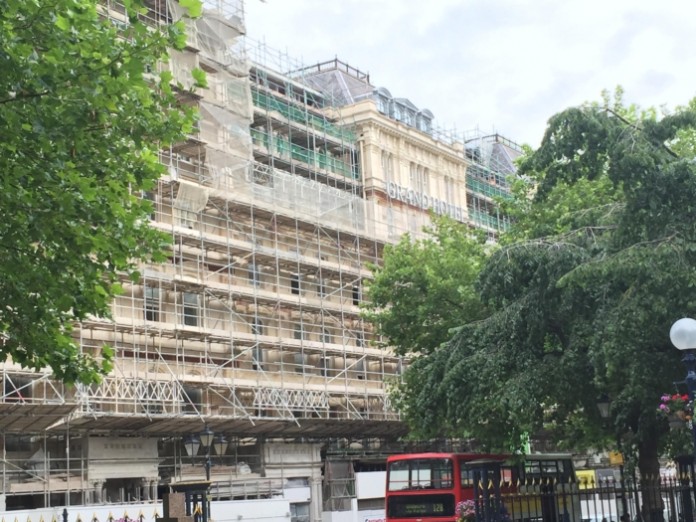Hortons’ Estate has completed the first phase of restoration works at The Grand on Colmore Row, Birmingham, at a cost of £4.1million.
Over the next two months the wraps will be taken off the ornate stone and marble façades of the historic building overlooking St Philip’s cathedral and Church Street, fully exposing them for the first time since 2003, when the building was shrouded following a fall of masonry.
The restoration has included stripping back thousands of stones by hand. Over the years, layers of cementitious render and paint were applied to the stonework to mask its decay. Each stone had to be individually examined to assess whether it could be repaired or totally replaced.
In addition, all 180 windows have been removed, repaired by skilled carpenters and re-installed. To help protect the façade from rainwater damage new flashing has been introduced and downpipes have been increased in size by 50 per cent.
Tony Green, chief executive of Hortons’ Estate, said: “In 2011 experts told us that the original stonework was of low durability and the facades of the building were beyond repair and would need to be demolished.
“However, Hortons’ and its professional team found a solution. It is testament to the determination and skill of the craftsmen involved – in particular the stonemasons – that the facades have not only been saved but their appearance is as it would have been when the building was first erected in the late 1800s.
“A decorative sandstone band running the length of the building and marble pilasters on the outside of the ground floor windows along Church Street are among the many original features that have been newly unmasked by the restoration works.”
James Slater, building surveyor at Hortons’ Estate, who has overseen the project, added: “The completion of the first phase of the project, which has taken four years, is a major milestone for all those involved in the restoration.
“Whilst there is still much work to be done to return the building to its former glory and full usage, the frontage is simply stunning and we are thrilled that it will once again grace the Colmore Row street scene.”
Historic England, formerly known as English Heritage, has contributed £200,000 to the project.
Sarah Lewis, principal adviser, Heritage at Risk for Historic England in the West Midlands, said: “The unveiling of The Grand after years shrouded in scaffolding is a really exciting moment for Historic England. We have supported the work, which is the first phase of a major repair and regeneration project, and we’re tremendously pleased with the high quality conservation achieved.
“It has been really rewarding and exciting to see the stonemasons uncovering lost details and revealing the architectural quality of the building’s original design once more.
“The splendour of the repaired façades is a tonic for the city centre, with the shabby, inappropriate shop fronts having been replaced with carefully designed new ones.”
Veryan Heal, Historic England, planning director West Midlands, added: “The Grand project represents a massive investment in Birmingham’s heritage. Historic England is here to help make heritage work, even when it seems most at risk, so we’re continuing to work closely with the team at Hortons’ Estate as they move on to the Barwick Street range of The Grand.”
Aldridge-based Midland Conservation Ltd supplied 40 highly skilled masons who used traditional tools and techniques to conserve and replicate the building’s decorative carved stone over a period of two-and-a-half years. 120 cubic metres of limestone, equating to 280 tonnes, was replaced by the team and retained stonework was carefully re-carved in situ to restore its intricate features.
Jason Graham, a director at the firm, said: “We applaud Hortons’ Estate for their ambitious restoration of this fine Victorian building, ensuring it will be on show for future generations. We are privileged to have been part of it.”
Cost consultants PMP and architects Berman Guedes Stretton advised Hortons’ Estate on the project. Arup Façade Engineering provided advice on stone conservation and architectural design.
Thomas Pearson, senior designer and conservationist at Arup, said: “The Grand is an important part of Birmingham’s history and it is fantastic to have not only ensured the building’s survival but unlocked its commercial future. There was a real concern about how the façade would look once its layers of render and decayed stone had been removed, but the result is even better than any of us hoped for.”
Further phases of restoration at The Grand are now underway.
A new roof and re-furbished shops and offices on Colmore Row, together with the restoration works to the Barwick Street façade, will be complete by the end of the year. The combined cost of these works is £6 million.
Tony Green said: “The completion of these phases will see us approaching the end of the works necessary to repair the external envelope.
“A further phase of works, to the Church Street interior, is currently out to tender and we aim to start that this year with completion next autumn.
“The shops and offices on Colmore Row have been well received by the market and we hope to announce some lettings soon.
“We are exploring solutions for the re-instatement of the hotel element of the scheme. However, the cost of creating an upmarket modern hotel within a Grade II* listed building is prohibitive compared to the value it creates. Our search for a financially viable solution continues.
“We have invested more than £13million in the scheme to date. Our commitment to bringing the whole building back to life, rather than simply restoring its fabric, remains undiminished.”



















